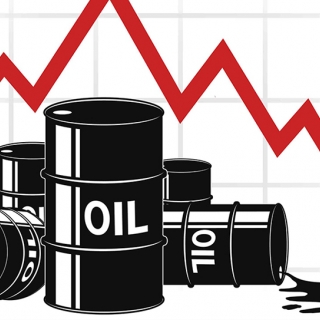


Oil prices plunged on Wednesday after the U.S. government released disappointing data on crude and fuel inventories ahead of the start of the summer driving season in the United States, a time of higher demand.
Prices had earlier risen about 1% after a report that Israel may be preparing to strike Iran's nuclear facilities raised concerns about supply disruptions in the Middle East.
Brent crude futures were down 8 cents at $65.30 a barrel by 10:52 a.m. EDT (1452 GMT). U.S. West Texas Intermediate crude was down 3 cents at $62.00.
U.S. crude, gasoline and distillate inventories all posted surprise increases in the week to May 16, the latest data from the Energy Information Administration showed on Wednesday.
Crude inventories rose by 1.3 million barrels, while gasoline stocks rose by about 800,000 barrels and distillate stocks rose by about 600,000 barrels.
"The EIA report showed a build in crude, gasoline and distillates, which is not something that market participants like," said Giovanni Staunovo, an analyst at UBS.
The data sent oil futures into the red after getting support earlier in the session from news that U.S. intelligence showed Israel was preparing to strike Iran's nuclear facilities, CNN reported on Tuesday, citing U.S. officials.
"Such an escalation would not only jeopardize Iranian supplies, but also much of the wider region," said ING's commodity strategist.
Given that Iran exports more than 1.5 million barrels per day (bpd), concerns about supply disruptions have helped push prices higher, UBS's Staunovo said.
Iran is the third-largest oil producer among the Organization of the Petroleum Exporting Countries (OPEC) and an Israeli attack could disrupt the flow of oil from the country.
There are also concerns that Iran could retaliate by blocking the flow of oil tankers through the Strait of Hormuz, through which Saudi Arabia, Kuwait, Iraq and the United Arab Emirates export crude and fuel.
"If tensions escalate, we will likely see a temporary trade shift or a supply cut of around 500,000 barrels per day - something that could be offset fairly quickly by OPEC+," said Rystad Energy analyst Priya Walia.
The U.S. and Iran have held several rounds of talks this year over Iran's nuclear program while U.S. President Donald Trump has revived a campaign of tougher sanctions on Iranian crude exports.
Despite the discussions, U.S. officials and Iran's Supreme Leader Ayatollah Ali Khamenei made comments on Tuesday that suggested the two sides were far from a settlement. Meanwhile, Kazakhstan's oil output rose by 2% in May, industry sources said on Tuesday, defying pressure from OPEC+ to cut output. (Newsmaker23)
Source: Reuters
Crude prices recovered from a midday dip on Friday on hopes Hungary can use Russian crude oil as U.S. President Donald Trump met Hungary's Prime Minister Viktor Orban at the White House. Brent crude ...
Oil prices rose on Friday (November 7th), but remained on track for a second straight weekly loss after three days of declines on oversupply concerns and slowing US demand. Brent crude rose 60 cents,...
Oil prices edged higher but remained on track for a second weekly decline. West Texas Intermediate (WTI) briefly approached $60 per barrel, while Brent held steady around $63 on Thursday. However, bot...
Oil prices declined on Thursday as investors considered a potential supply glut, as well as weakened demand in the United States, the world's largest oil consumer. Brent crude futures settled down 14...
Oil prices edged higher on Thursday (November 6), boosted by easing concerns over a potential oversupply as sanctions against Russian companies began to take effect. After closing at a two-week low i...
Crude prices recovered from a midday dip on Friday on hopes Hungary can use Russian crude oil as U.S. President Donald Trump met Hungary's Prime Minister Viktor Orban at the White House. Brent crude futures settled at $63.63 a barrel, up 25 cents...
US stocks rebounded from early losses to close mostly higher on Friday amid hopes that Congress members were making progress toward ending the government shutdown. The S&P 500 and the Dow Jones closed 0.3% higher, while the tech-heavy Nasdaq...
European stocks fell on Friday as investors digested more quarterly earnings, but weekly losses were inevitable, with concerns regarding overheated valuations evident. The DAX index in Germany dropped 0.8% and the CAC 40 in France declined 0.2%,...
 The U.S. Supreme Court's tough questioning of President Donald Trump's global tariffs has fueled growing speculation that they will be overturned,...
The U.S. Supreme Court's tough questioning of President Donald Trump's global tariffs has fueled growing speculation that they will be overturned,...
 European stocks opened lower on Thursday, as investors reacted to another flurry of corporate earnings.
The pan-European Stoxx 600 was 0.3% lower...
European stocks opened lower on Thursday, as investors reacted to another flurry of corporate earnings.
The pan-European Stoxx 600 was 0.3% lower...
 European stocks fell on Friday as investors digested more quarterly earnings, but weekly losses were inevitable, with concerns regarding overheated...
European stocks fell on Friday as investors digested more quarterly earnings, but weekly losses were inevitable, with concerns regarding overheated...
 Two weeks before the US Federal Reserve's final meeting, with the federal government's data taps closed, Atlanta Fed staff bolstered their economic...
Two weeks before the US Federal Reserve's final meeting, with the federal government's data taps closed, Atlanta Fed staff bolstered their economic...